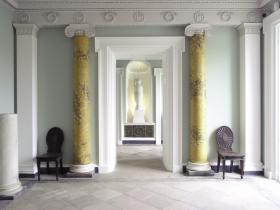Fota House, Co. Cork
Published in 18th–19th - Century History, Features, General, Issue 5 (Sep/Oct 2009), Volume 17
The remodelled hall—paired Ionic columns in a rich yellow scagliola (a simulated marble produced from marble chips) give a strong architectural character to the space. (NIAH)
Fota House would have been a very different place but for the exertions of John Smith-Barry (1793–1837) of Marbury Hall, Cheshire. Having decided in the early nineteenth century to make Fota his permanent Irish home, in about 1825 Smith-Barry commissioned (Sir) Richard Morrison (1767–1849) and his son, William Vitruvius Morrison (1794–1838), to extend an existing hunting lodge, a modest square block, into the stately mansion we see today.
A formidable architectural team, the Morrisons had a number of projects under way across Ireland at the time of the reconstruction of Fota House, including the Tudor-revival Killruddery House, Co. Wicklow, and the classical Ballyfin House, Co. Laois. The elder Morrison would later be knighted, largely in recognition of his role in the foundation in 1839 of the Institute of the Architects of Ireland. William Vitruvius, meanwhile, had embarked on a Grand Tour of Europe: his studies of classical antiquity would have a great effect on the appearance of the ‘new’ Fota House.
Declining an Elizabethan makeover credited to the younger Morrison, Smith-Barry settled on a classical scheme, attributable as a collaboration between father and son, which would better integrate the hunting lodge. This was achieved by removing the internal partitions of the existing block, thereby opening up the ground floor as a central hall. Additional blocks at either end were created to house the principal dining-room (north) and drawing-room (south).
The centrepiece of the house remains the remodelled hall, one of the finest neo-classical interiors in Ireland. Entered through a Roman Doric portico carved from blue limestone, the progression of the classical order culminates in the Grecian columnar screens replacing the previous partitions. Paired Ionic columns in a rich yellow scagliola, a simulated marble produced from marble chips, give a strong architectural character to the space. The forced perspective of the hall is cleverly elongated by views through to niches at each extremity that feature plaster reproductions of urns designed by Richard Morrison for Lyons House, Co. Kildare.
The large dining-room, to the left of the hall, also features an elegant columnar screen, this time fashioned from a cool grey scagliola with impressive Corinthian capitals. The ceiling, along with the ceiling of the opposing drawing-room, was executed in the 1890s by the firm of Henry Sibthorpe and Son (founded 1747) of Dublin. Acquiring a reputation for generous hospitality, Smith-Barry was fondly nicknamed ‘John the Magnificent’, and the impressive hall and beautiful suite of reception rooms at Fota House all stemmed from the host’s desire to entertain, if not impress, visiting guests. Later nineteenth-century improvements included the billiard room built in 1872 to designs by Sir John Benson (1812–74), while Benson’s contemporary conservatory was later adapted in 1897 by Arthur Hill (1846–1921) as the present long gallery.
Fota House and its grounds occupy a sheltered wooded island in Cork Harbour and benefit from an extremely benign microclimate, ideal for a great diversity of rare and tender perennial plants. The estate has long been renowned for the expertise of the Smith-Barrys and their gardeners, and this standard has been maintained by the Office of Public Works.
Sold by the last of the family to University College Cork in 1975, a successful restoration of the first floor of Fota House has just been completed. This, along with the donation of substantial collections of art and furniture, has contributed significantly to its reinvigoration. In addition, a range of diverse activities, catering for all ages, might be considered a contemporary spin on John the Magnificent’s desire to create a house worthy of the admiration and pleasure of the visitor. HI
Kevin Baird is Chief Executive Officer of the Irish Heritage Trust (www.irishheritagetrust.ie). Series based on the National Inventory of Architectural Heritage’s ‘building of the month’.
















